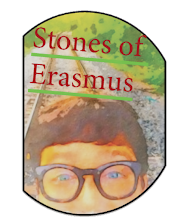Donatello's Bronze David is on display in Museo Nazionale del Bargello in Florence.
 |
| Donatello, "Bronze David," circa 1440 |
Florence's Two Davids
Florence claims two famous David's: the one above is Donatello's bronze rendition, while Michelangelo's David is carved from marble. This "David" is remarkably younger in appearance and less muscular than Michelangelo; he displays an insouciance characteristic of a boy who has just brazenly done a misdeed and is gloating. He leans forward on his sword, pleased with knocking down the Philistine Goliath with a mere stone, then lopping off his head. I am sure the adrenaline seething through his body after such an act was powerful indeed.
Donatello's David is Presented "After the Act"
It is interesting that Donatello has chosen to depict his David post coitus. His stance is certainly not the preliminary "taking stock" embodied in Michelangelo's David nor is it the intense focus of a David in action with the slingshot; it seems obvious his victory is more akin to losing one's virginity or the discovery of masturbation. Donatello's David is a piece that glorifies the esteem begotten in accomplishing a deed rather than the energy and labor that go into completing one.
Pure Youth Energy
Not just any deed. But a deed done quickly and with fierce attention, and brazen courage, against all odds. Who would guess that a boy could topple a giant? Who would guess that after having made love for the first time that it would be so good? The trope evident here is of the victorious boy. He is a boy fully clad in the remnant clothing of a warrior, the helmet and the battle sandals. The rest is pure youth.
photo credit: timelines
Florence claims two famous David's: the one above is Donatello's bronze rendition, while Michelangelo's David is carved from marble. This "David" is remarkably younger in appearance and less muscular than Michelangelo; he displays an insouciance characteristic of a boy who has just brazenly done a misdeed and is gloating. He leans forward on his sword, pleased with knocking down the Philistine Goliath with a mere stone, then lopping off his head. I am sure the adrenaline seething through his body after such an act was powerful indeed.
Donatello's David is Presented "After the Act"
It is interesting that Donatello has chosen to depict his David post coitus. His stance is certainly not the preliminary "taking stock" embodied in Michelangelo's David nor is it the intense focus of a David in action with the slingshot; it seems obvious his victory is more akin to losing one's virginity or the discovery of masturbation. Donatello's David is a piece that glorifies the esteem begotten in accomplishing a deed rather than the energy and labor that go into completing one.
Pure Youth Energy
Not just any deed. But a deed done quickly and with fierce attention, and brazen courage, against all odds. Who would guess that a boy could topple a giant? Who would guess that after having made love for the first time that it would be so good? The trope evident here is of the victorious boy. He is a boy fully clad in the remnant clothing of a warrior, the helmet and the battle sandals. The rest is pure youth.
photo credit: timelines


























